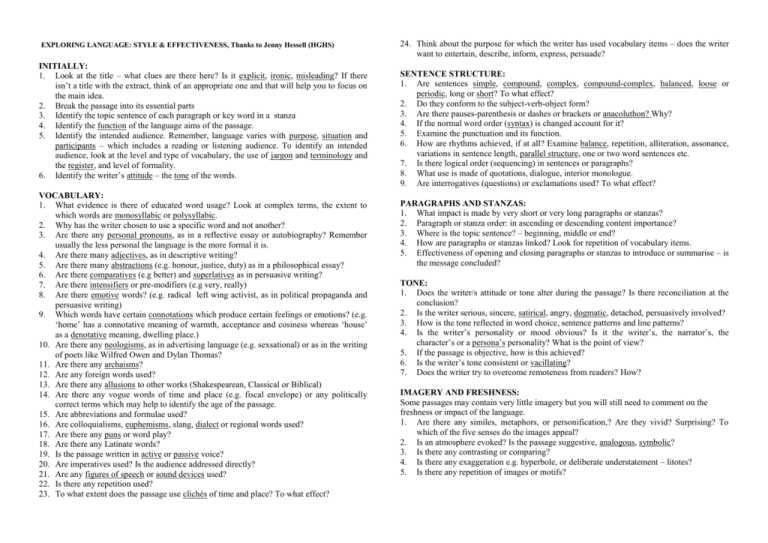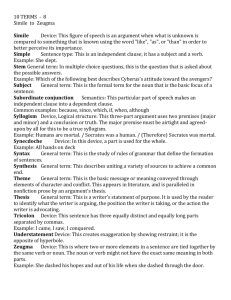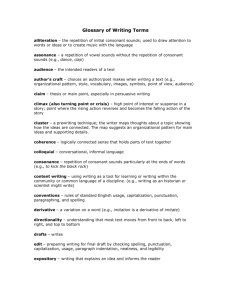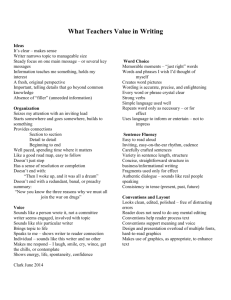EXPLORINGLANGUAGE-Styleandeffectiveness(handout)
advertisement

EXPLORING LANGUAGE: STYLE & EFFECTIVENESS, Thanks to Jenny Hessell (HGHS) INITIALLY: 1. Look at the title – what clues are there here? Is it explicit, ironic, misleading? If there isn’t a title with the extract, think of an appropriate one and that will help you to focus on the main idea. 2. Break the passage into its essential parts 3. Identify the topic sentence of each paragraph or key word in a stanza 4. Identify the function of the language aims of the passage. 5. Identify the intended audience. Remember, language varies with purpose, situation and participants – which includes a reading or listening audience. To identify an intended audience, look at the level and type of vocabulary, the use of jargon and terminology and the register, and level of formality. 6. Identify the writer’s attitude – the tone of the words. VOCABULARY: 1. What evidence is there of educated word usage? Look at complex terms, the extent to which words are monosyllabic or polysyllabic. 2. Why has the writer chosen to use a specific word and not another? 3. Are there any personal pronouns, as in a reflective essay or autobiography? Remember usually the less personal the language is the more formal it is. 4. Are there many adjectives, as in descriptive writing? 5. Are there many abstractions (e.g. honour, justice, duty) as in a philosophical essay? 6. Are there comparatives (e.g better) and superlatives as in persuasive writing? 7. Are there intensifiers or pre-modifiers (e.g very, really) 8. Are there emotive words? (e.g. radical left wing activist, as in political propaganda and persuasive writing) 9. Which words have certain connotations which produce certain feelings or emotions? (e.g. ‘home’ has a connotative meaning of warmth, acceptance and cosiness whereas ‘house’ as a denotative meaning, dwelling place.) 10. Are there any neologisms, as in advertising language (e.g. sexsational) or as in the writing of poets like Wilfred Owen and Dylan Thomas? 11. Are there any archaisms? 12. Are any foreign words used? 13. Are there any allusions to other works (Shakespearean, Classical or Biblical) 14. Are there any vogue words of time and place (e.g. fiscal envelope) or any politically correct terms which may help to identify the age of the passage. 15. Are abbreviations and formulae used? 16. Are colloquialisms, euphemisms, slang, dialect or regional words used? 17. Are there any puns or word play? 18. Are there any Latinate words? 19. Is the passage written in active or passive voice? 20. Are imperatives used? Is the audience addressed directly? 21. Are any figures of speech or sound devices used? 22. Is there any repetition used? 23. To what extent does the passage use clichés of time and place? To what effect? 24. Think about the purpose for which the writer has used vocabulary items – does the writer want to entertain, describe, inform, express, persuade? SENTENCE STRUCTURE: 1. Are sentences simple, compound, complex, compound-complex, balanced, loose or periodic, long or short? To what effect? 2. Do they conform to the subject-verb-object form? 3. Are there pauses-parenthesis or dashes or brackets or anacoluthon? Why? 4. If the normal word order (syntax) is changed account for it? 5. Examine the punctuation and its function. 6. How are rhythms achieved, if at all? Examine balance, repetition, alliteration, assonance, variations in sentence length, parallel structure, one or two word sentences etc. 7. Is there logical order (sequencing) in sentences or paragraphs? 8. What use is made of quotations, dialogue, interior monologue. 9. Are interrogatives (questions) or exclamations used? To what effect? PARAGRAPHS AND STANZAS: 1. What impact is made by very short or very long paragraphs or stanzas? 2. Paragraph or stanza order: in ascending or descending content importance? 3. Where is the topic sentence? – beginning, middle or end? 4. How are paragraphs or stanzas linked? Look for repetition of vocabulary items. 5. Effectiveness of opening and closing paragraphs or stanzas to introduce or summarise – is the message concluded? TONE: 1. Does the writer/s attitude or tone alter during the passage? Is there reconciliation at the conclusion? 2. Is the writer serious, sincere, satirical, angry, dogmatic, detached, persuasively involved? 3. How is the tone reflected in word choice, sentence patterns and line patterns? 4. Is the writer’s personality or mood obvious? Is it the writer’s, the narrator’s, the character’s or a persona’s personality? What is the point of view? 5. If the passage is objective, how is this achieved? 6. Is the writer’s tone consistent or vacillating? 7. Does the writer try to overcome remoteness from readers? How? IMAGERY AND FRESHNESS: Some passages may contain very little imagery but you will still need to comment on the freshness or impact of the language. 1. Are there any similes, metaphors, or personification,? Are they vivid? Surprising? To which of the five senses do the images appeal? 2. Is an atmosphere evoked? Is the passage suggestive, analogous, symbolic? 3. Is there any contrasting or comparing? 4. Is there any exaggeration e.g. hyperbole, or deliberate understatement – litotes? 5. Is there any repetition of images or motifs? From The Mindless Enemy Exploring Language – Terms & Definitions Explicit: openly stated (cf. Implicit/implied) Ironic: (a) where the intended meaning is different from the stated meaning. The effect can be humorous or mildly sarcastic. (b) where the outcome of a situation is the opposite of what is expected. The effect is incongruous or startling or tragic. Function: the purpose for which the langugae is used Ask yourself.. is the purpose 3) 4) slang. Sentences are correctly structured without being complex. e.g. the way a newsreader speaks, or a well educated person writes a report. INFORMAL: Friendly, relaxed language used in everyday situations. Unplanned, and therefore colloquial, full of idioms and clichés, and sentence structure loose. NON-STANDARD: highly informal, often characteristic by slang. May include errors in vocabulary and syntax/grammar. Includes jargon, coinages, dialect, swearing. Tone: The ‘character’ of language, which comes from the writer/speaker’s attitude to the subject or audience. This attitude will influence both the choice of words and their arrangement. Tone can be: 1) POSITIVE (approving, praising, enthusiastic, humorous) 2) NEUTRAL 3) NEGATIVE (critical, disapproving, angry, ironic, sarcastic) INFORMATIVE - to inform to explain to instruct EXPRESSIVE - to describe to narrate to reflect to share an experience Monosyllabic: Words of one syllable. A line of monosyllabic words has a very definite rhythm, which can be touching in its simplicity: e.g. when I am dead, my dear, sing no sad songs for me. OR stirring and exclamatory: Death, thou shalt die! PERSUSIVE - to convince Polysyllabic: words of several syllables. They can be used just as effectively. Because they take longer to say we have time to dwell on them. Situation: what is happening, the occasion or event? Participants: the people involved. We can establish the nature of their relationship by asking: 1) Who are the people involved? Does the language give clues? – sex, age, education, occupation, geographic, or ethnic origin. 2) Can the language be identified with any particular activity, occupation or context (Marae ceremony, rugby match) 3) How formal/informal is the relationship? Are there indications of equality, respect, dominance, deference. 4) Does the tone suggest what their attitudes are to each other? Level of formality: Different situations and contexts cause us to adjust our language, the level of formality will result in characteristic features of vocabulary/diction, sentence structure/syntax and presentation. There are four broad levels of formality (both written and spoken) 1) 2) FORMAL: carefully planned, thoughtful, polished language featuring complex vocabulary and sentence structures. Often directed at an educated audience. e.g. literature/oratory. STANDARD: correct, precise language, free of colloquialisms and Personal pronouns: used in place of nouns to avoid clumsy repetitiveness. They can be inclusive (we), for direct address (you), or ‘to isolate the enemy’ (they/them), and are employed to great effect in public speaking. NB: ‘my, your, our, their’ are possessive adjectives, not pronouns. Adjectives: sometimes called qualifiers or modifiers, they are used to describe nouns and pronouns and are therefore an essential element in descriptive writing. They can come before (pre-nominal) or after (post-nominal) the noun or pronoun. The adjectival phrase is a group of words (without a verb) which form the same function as an adjective. e.g. the injured boy died (adjective), the boy with the broken neck died (adjectival phrase) Abstractions: Abstract nouns name ideas (justice, peace, truth) and feelings (happiness, hatred, disappointment) Comparatives: adjectives which compare using ‘er’ or ‘more…’ e.g. bigger, faster, most wonderful. Superlatives: adjectives which compare using ‘est’ or ‘most..’ e.g. biggest, fastest, most wonderful. Intensifiers: words which are used to emphasise an adjective. e.g. pretty amazing, a bit eccentric, rather untidy, very funny, really dumb. Emotive: Emotive words appeal to the emotions, arousing feelings of approval or disapproval. Emotive words are found in persuasive language (e.g. oratory, advertising). A writer’s attitude towards the subject is clearly conveyed in the choice of emotive words. e.g. She’s a babe (approving) she’s a slut (disapproving) Connotations: the emotional associations suggested by a word. E.g. Dove = peace, freedom. Rose = romance, love. Denotation: the literal meaning of a word e.g. snake denotative meaning = legless reptile. Connotations = cunning, evil. E.g. red denotative meaning = a colour, positive connotation = love, negative connotation = danger or communism? Neologisms: newly made up words. They can be formed in several ways: 1) Coinage e.g. zespri (new word for kiwifruit) 2) Compounding E.G. Green peace (joining of ‘green’ and ‘peace’) 3) Blending (portmanteau words) e.g. seducaps (sleeping pills) formed by blending ‘sedative’ and ‘capsule’ 4) Phonetic spelling e.g. Ezibuy Archaisms: words no longer in common use. E.g. herein Allusion: an indirect reference to people and events in literature and history. E.g. our city is like the garden of Eden. Euphemism: a mild word or phrase used instead of an offensive or frank one. E.g. ‘to pass away’ for ‘to die’ Dialect: a form of language spoken in a particular geographical area or by a particular social class or ethnic or occupational group Pun: the use of a word or words to exploit ambiguity or innuendo with humorous effect because of the double meaning. e.g. electrocution – a shocking experience, malnutrition – food for thought. Active Voice: when the subject of the sentence performs the action. E.g. a guest complained. Passive Voice: where the subject has the action performed upon them e.g. a complaint was made by a guest. Imperative: A command (‘sit down’) or request (Let me help) The subject (you) is implied, not stated. Imperatives are used to give instructions (add butter) and in advertising to promote action (Buy now, hurry) Figures of speech/figurative language/imagery: description by comparison. While it includes: paradox, hyperbole, litotes, allusion (in other words any device used to create an image) it frequently refers to: 1) Simile: An indirect comparison, linking the items being compared by using ‘like’ or ‘as’ e.g. ‘He looked like he’d seen a ghost’ 2) Metaphor: a direct comparison, describing something as if it were something else. E.g. I had to hold my tongue. You hair is spun gold 3) Personification: describing a non-human item in human terms. E.g. Justice is blind, The wind whispered.. Sound devices: Can be pleasing to the ear, strengthen imagery, convey real sounds, promote rhythm, emphasise words, provide links between thoughts. 1) Rhythm – all language has a rhythm, though it is less obvious in prose than in poetry. a) The rhythm in poetry is produced by the ‘metre’ (the number of stressed beats in a line) It depends on what combination of syllable patterns is used and also on where the punctuation is placed. for example poems with run-on lines(enjambment) will have quite a different rhythm from poems with end-stopped lines (where there is punctuation – comma, colon, full stop - at the end of the line) the flow/pace of poetry will tend to closely parallel the meaning and mood. For example, rising rhythm (One unstressed syllable followed by a stressed syllable – iambic) can suggest a happy mood. Falling rhythm (stressed to unstressed) can suggest melancholy. b) the sounds of words can also affect the rhythm (long/short/harsh/soft) long vowels tend to draw out the pace e.g. lay, dream, fine short vowels tend to speed it up e.g. hit, rock, gulp soft consonant sounds are melodic – l, r, m, n, ng hard consonant sounds are abrupt – b, d, g, t, k hissing/sibilant sounds are also used to effect – s,ch, j c) monosyllabic words have a different rhythm from polysyllabic words 2. Rhyme – the deliberate repetition of the same or similar sounds to give a poem unity and make it interesting to read and easy to memorise (poetry was part or oral tradition long before it was written down) a) rhyme scheme – the pattern of end rhymes in a poem. Each rhyming sound at the end of a line is marked with a different letter and the letters indicate the rhyme scheme) b) exact rhyme – identical vowel sound, different consonant preceding the vowel, same consonant following vowel e.g. song/long, hope/rope c) d) e) half rhyme (near rhyme) – similar vowel sounds e.g. throne/soon, love/ gave eye rhyme (slant rhyme) – words look a like but are pronounced differently e.g. rough/bough, go/do internal rhyme – has at least one of the rhyming words within the line e.g. let us weep for those who sleep. 3. other sound devices (a) alliteration – the deliberate repetition of the same or similar consonant sounds, usually at the beginning of words to create mood or suggest meaning or enhance rhythm e.g. the eagle clasped the crag with crooked hands. (b) assonance – as above, for vowel sounds e.g. to dream the peaceful sleep of death (c) consonance – the repetition of identical consonant sounds before and after different vowel sounds e.g. pitter, patter slip slop slap. (d) Onomatopoeia – where the sound and the word echoes or suggests its meaning e.g. crash, tinkle, moo, buzz, whoosh Clichés: overused and therefore dull, stale phrases e.g. she was shaking like a leaf but put her best foot forward. is to speak, at dinner (Underlined = noun phrase) (italicised = verb phrase) (at dinner = adverbial phrase) Types of Sentences: Simple Sentence: has one clause only (one subject, one complete verb) Because a simple sentence can contain any number of phrases it is not always short. Compound Sentence: has two or more clauses of equal importance linked by co-ordinating conjunction(s) – and, but, or. E.g. I hit him and made his nose bleed. (Subject ‘I’ is implied) Complex Sentence: has at least one main or principal clause and at least one subordinate or dependant clause. e.g. When he hit me (subordinate clause), I cried. (main clause. Compound-complex clause: a mixture of the above. This means that the sentence must contain at least three complete verbs in three clauses joined by one co-ordinating conjunction and one subordinate conjunction. Sentence Structure: Balanced/parallel: has two main clauses, often in contrast with each other (anthises) Because it can sound clever, you will find it in oratory and epigrams. e.g. To err is human, to forgive divine. (Complete verb ‘is’ is implied) Sentence: Loose sentence: a group of words containing a finite (complete i.e. verb + subject) verb arranged in such a way as to express a complete thought. Sentences range in length from one word e.g. Look! Where the subject of the sentence, you, is implied to a whole page. Subject: the person or thing that the sentence is about Predicate: all of the sentence except the subject. The predicate must contain a completed verb. Clause: a group of words with a complete verb. The word ‘clause’ is usually used to describe groups of words linked by conjunctions. e.g. The rains come and the plants flourished. ( = clause) A clause will always have its own subject and predicate and therefore could stand alone as a sentence. e.g. Pedro and Paul walk to school together and Jean walks with me subject Phrase: predicate subject predicate a small group of words which convey meaning but could not make a complete sentence of its own. e.g. An important woman from the ministry, the main clause comes at the beginning of the sentence. This is the most widely used and most natural sounding type. Periodic sentence: the main clause comes at the end of the sentence. The periodic sentence can be very dramatic, ending as it does on a strong note. E.g. With a glint in his eye and a smile on his face, he asked her out (main clause) Short sentences: because they have impact, short sentences are often used to begin and end a passage of writing or a speech. A series of short sentences create a racy rhythm. Anacoluthon: where a sentence changes construction part way through. e.g. can we go … we want to go to the movies Inversion: A change in the normal word order. e.g. on to his knees he fell. Syntax: the arrangement of words in a sentence. Satirical: Satire is using humour to make fun of a person or thing. Dogmatic: firm and authoritative, often to the point of arrogance. Persona: where a writer is not speaking in his or her own voice but takes on another identity (from Greek: ‘a mask’) The following terms are often used in Bursary questions. Make sure you are clear about their Meaning: Vacillating: constantly changing. Instructions Analogous: a comparison to show the similarity between two things or ideas Symbolic: a symbol is something which stands for something else. e.g. white is a symbol of purity. The cross is a symbol for Christianity. Symbols help us to understand and visualise ideas by providing a concrete image for an abstract concept. Identify Discuss Illustrate Compare Contrast Technical Terms Content Form Structure Register Diction Semantics Figures of Speech Imagery Symbolism Sound devices Syntax Grammar Point of View Tone Litotes: deliberate understatement. e.g. She’s not bad looking. Motif: a recurring idea or image or symbol which creates a pattern Remember in commenting on the STYLE of a passage, you are expected to…. IDENTIFY features (name devices used and quote examples) EXPLAIN the intended effect ( You must be specific and convincing. Comments such as ‘This helps the poem flow’ or ‘This creates a vivid image’ mean nothing without detailed explanation. SUPPORT, EXPAND, JUSTIFY your opinions with reasons and examples. KEY STEPS TO ANALYSIS: PURPOSE What is the writer’s purpose? Which words show this? VOICE/SPEAKER What are they saying? Who to? What is their attitude (Tone) How do you know? How do you know? How do you know? STYLE How are they saying it? What sort of vocabulary? What language techniques? Sentence types + syntax? What overall structure? WHAT EFFECT IS AIMED AT?




